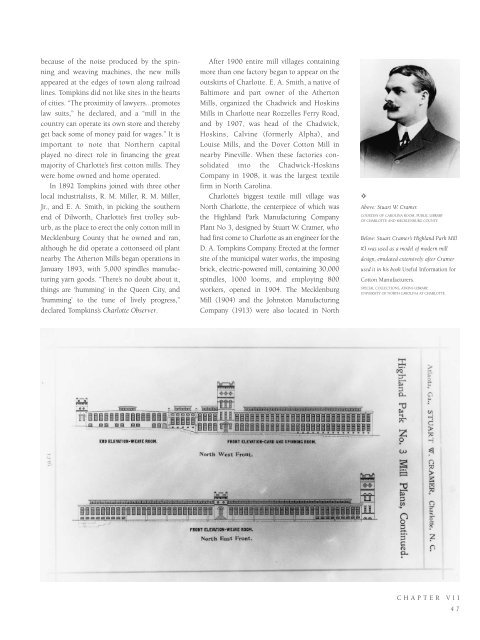Historic Charlotte
An illustrated history of the City of Charlotte and the Mecklenburg County area, paired with the histories of companies, families and organizations that make the region great.
An illustrated history of the City of Charlotte and the Mecklenburg County area, paired with the histories of companies, families and organizations that make the region great.
Create successful ePaper yourself
Turn your PDF publications into a flip-book with our unique Google optimized e-Paper software.
ecause of the noise produced by the spinning<br />
and weaving machines, the new mills<br />
appeared at the edges of town along railroad<br />
lines. Tompkins did not like sites in the hearts<br />
of cities. “The proximity of lawyers...promotes<br />
law suits,” he declared, and a “mill in the<br />
country can operate its own store and thereby<br />
get back some of money paid for wages.” It is<br />
important to note that Northern capital<br />
played no direct role in financing the great<br />
majority of <strong>Charlotte</strong>’s first cotton mills. They<br />
were home owned and home operated.<br />
In 1892 Tompkins joined with three other<br />
local industrialists, R. M. Miller, R. M. Miller,<br />
Jr., and E. A. Smith, in picking the southern<br />
end of Dilworth, <strong>Charlotte</strong>’s first trolley suburb,<br />
as the place to erect the only cotton mill in<br />
Mecklenburg County that he owned and ran,<br />
although he did operate a cottonseed oil plant<br />
nearby. The Atherton Mills began operations in<br />
January 1893, with 5,000 spindles manufacturing<br />
yarn goods. “There’s no doubt about it,<br />
things are ‘humming’ in the Queen City, and<br />
‘humming’ to the tune of lively progress,”<br />
declared Tompkins’s <strong>Charlotte</strong> Observer.<br />
After 1900 entire mill villages containing<br />
more than one factory began to appear on the<br />
outskirts of <strong>Charlotte</strong>. E. A. Smith, a native of<br />
Baltimore and part owner of the Atherton<br />
Mills, organized the Chadwick and Hoskins<br />
Mills in <strong>Charlotte</strong> near Rozzelles Ferry Road,<br />
and by 1907, was head of the Chadwick,<br />
Hoskins, Calvine (formerly Alpha), and<br />
Louise Mills, and the Dover Cotton Mill in<br />
nearby Pineville. When these factories consolidated<br />
into the Chadwick-Hoskins<br />
Company in 1908, it was the largest textile<br />
firm in North Carolina.<br />
<strong>Charlotte</strong>’s biggest textile mill village was<br />
North <strong>Charlotte</strong>, the centerpiece of which was<br />
the Highland Park Manufacturing Company<br />
Plant No 3, designed by Stuart W. Cramer, who<br />
had first come to <strong>Charlotte</strong> as an engineer for the<br />
D. A. Tompkins Company. Erected at the former<br />
site of the municipal water works, the imposing<br />
brick, electric-powered mill, containing 30,000<br />
spindles, 1000 looms, and employing 800<br />
workers, opened in 1904. The Mecklenburg<br />
Mill (1904) and the Johnston Manufacturing<br />
Company (1913) were also located in North<br />
✧<br />
Above: Stuart W. Cramer.<br />
COURTESY OF CAROLINA ROOM, PUBLIC LIBRARY<br />
OF CHARLOTTE AND MECKLENBURG COUNTY.<br />
Below: Stuart Cramer’s Highland Park Mill<br />
#3 was used as a model of modern mill<br />
design, emulated extensively after Cramer<br />
used it in his book Useful Information for<br />
Cotton Manufacturers.<br />
SPECIAL COLLECTIONS, ATKINS LIBRARY,<br />
UNIVERSITY OF NORTH CAROLINA AT CHARLOTTE.<br />
CHAPTER VII<br />
47
















